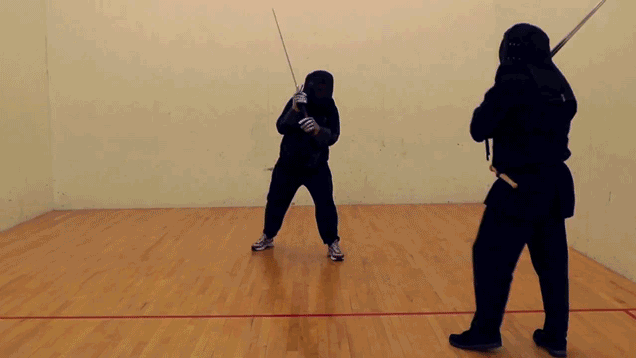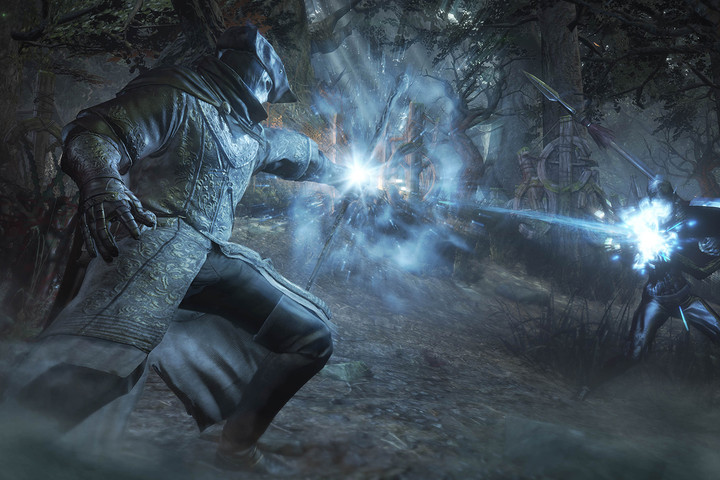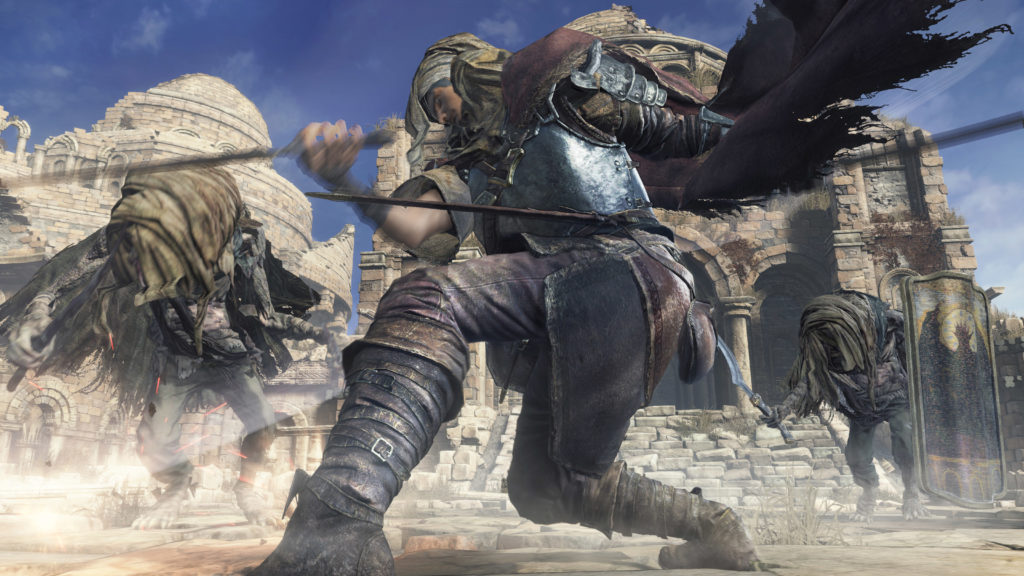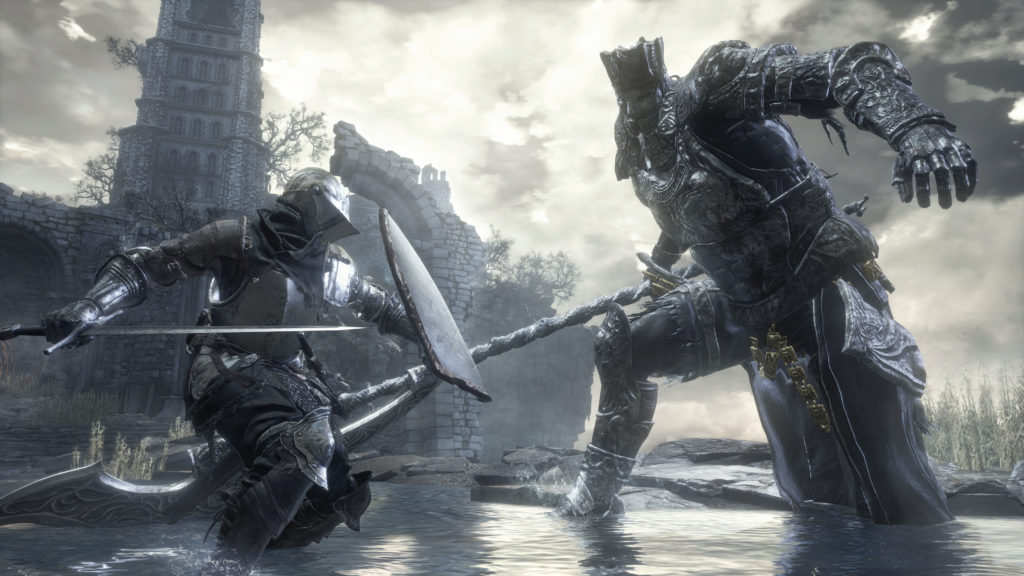Last updated on June 14, 2016
Part 1
Combat
Not surprisingly, that sense of “Souls” also returns in the form of a (yet again) enhanced system. Apparently, Dark Souls III cribs a lot from Bloodborne’s enhanced pace; I can’t really confirm that, given that I haven’t played the PS4 exclusive yet, but the new Souls game definitely exhibits a faster pace than any of its predecessors! Like in Dark Souls II, fighting enemies in Dark Souls III takes persistence and good timing; the prevalence of multi-enemy groups returns, but with a better sense of balance and the constraints of the camera system.
The biggest change, however, is in another nerf to Poise. I tend towards heavy armor build with a greatshield to go through every Souls, and they’ve made subtle changes that make the game far harder with that build than in Dark Souls I or II. Poise will no longer let you attack through enemy attacks unless you stack it astronomically high, and even if you could heavy armor doesn’t reduce your damage toll enough. At a point, you could finally block enemy attacks consistently in Dark Souls II, but no such luck here! Multiple enemy groups ripped through my stamina bar, even with the highest stability greatshield I could find. This is a clear indication that something’s changed!
That something is “dodging”, which now becomes the absolutely most essential movement to learn in the entire game. Dark Souls III returns to consistent dodge timings, without the mess of Adaptability as a statistic for your character. As such, every enemy and boss in the game doesn’t let you use a big shield and some big armor as a crutch to get through particularly tricky boss patterns. I love that they basically yanked me right out of my comfort zone! It was only when I accepted that sword-and-board simply wasn’t viable without dodging that I could best these combat encounter.

Like Dark Souls II but even heightened, the game teaches you the virtue of patience, stamina monitoring, and not getting greedy when the time comes to attack. If you get staggered when two giant guys want to smack you around, that’s a recipe for disaster. Most enemies can, and will, finish their combos without giving you any opportunity to roll or block, so you better make sure it’s going to hit. Enemies hit quite a bit harder too, and do far more stamina damage to boot when you block. These are excellent changes which force a patient hit-and-run strategy, but an exciting one! The tension-release becomes quite high-strung during boss fights where you multi-task several enemies at once – thankfully, they are much better designed this time around! A measured, focused combination of blocking and dodging will do you far more good than any other defensive option, but the player has to figure out how to use these tools.
It goes without saying that a number of other strange systems in Dark Souls II also reverted back to their Dark Souls I form in the new game. The parry from Dark Souls I returns with nary a change, and the backstab also looks identical. The wonky timings for both disappear, as they still work exactly as in the first game; with Dark Souls II, a missed backstab had an failure animation, which was thankfully omitted here. The kick also returns, which replaces the godawful shield bash thing that always had too much startup! Unsurprisingly, Dark Souls III also eliminates Lifegems in favor of the old, reliable Estus Flask system. Once again, healing items are limited and you are required to figure out the best times to heal; the combat situations seem tailored to this lack of healing items, and that’s wonderful.
In a strange change, magic builds and spells make the game significantly harder. Usually, it’s the other way around, but there’s some subtle additions that complicate things. Magic costs now costs Focus; run out, and you can’t cast any spells. However, you can hold onto Ashen Flasks, which let you recover your FP, but you have to allocate Estus Flasks to that purpose. Thus, most casters will probably end up with less healing overall (fitting, in a way, for a high-risk/reward playstyle). Add the relentless enemy attacks, and that makes magic use very hard! I’m not sure if this is a good reversal of “magic being easy mode”, but one thing’s for sure – now no class is easy!

I should also mention that Focus is used for Weapon Arts – literally, special attacks attached to each weapon with high damage, special properties, and the like. For PvE purposes, I could never figure out if they were useful or not. I imagine a PvP player might enjoy these more, but the risks usually outweigh the benefits for these new abilities in pure exploration mode. As such, I can’t say much for them, other than that they add depth to your choice of equipment, and that’s certainly an improvement (even if I barely used it).
Still, the combat does prompt some complaining from me, despite me liking the new faster pace and emphasis on timed dodging. First, there’s still a problem with “giant” bosses. I’m not sure why I didn’t have this problem in earlier games, but this one came about especially in the Cursed Greatwood fight. Some bosses, even when you lock-on, are simply too tall. As such, if they start an attack above where you can see them, you either need to hear the audio tell or just become psychic with a total guess roll. That especially applies when big enemies leap above your head, and they simply fall on you. It’s just strange, and there’s a lot of bosses with this ability in the game for whatever reason.
Like in previous games, you can certainly bug many enemy encounters out. While they removed the “I aggro forever” enemy AI behavior, I still found ways to cheese out enemies with arrows. I suppose From Software can’t fix every issue like this, but that problem remains five games in somehow, and I figured they’d find ways to fix it. At least none of the areas force tons of enemies into a tiny corridor, forcing you to run to a door they can’t get through; I will note the relative lack of such areas, and the designers having the good sense to limit the number of enemies in those spaces to 1 or 2 big ones instead of a giant horde.


I’m most surprised by the boss variety, though. Unlike Dark Souls II’s “multiple enemy encounter” trope, Dark Souls III amps up the variety for each and every boss, and even within the boss fights themselves! Most of them take place in multiple phases, and usually this completely changes your approach to the encounter. As well, “puzzle” bosses from Demon’s Souls return, which require the player to figure out a very specific method to defeat them. I like this change of pace, because it forces you to analyze your environment and think outside the box to actually win! One in particular had me wrack my brain for a bit before understanding it required a special weapon art.
Even so, the most difficult fight (for me, anyway) was the Abyss Watchers. None of the multi-enemy fights of Dark Souls II really test you in quite the same way, as these enemies can and will break through your guard. If you thought enemies had tracking in Dark Souls III, wait until you get a load of these guys. Nearly every enemy in the game attacks in a way that forces a dodge or block, and the Watchers really emphasize this to the point of mastery. But, the pace is just right – no longer do you fumble with the camera to figure out where “the other guy” is, because the enemies have a deliberate attack pattern and pace. That goes for every multiple-enemy fight, as well – the AI now coordinates their attacks, or punishes you for preventing them, which makes the player proactive in figuring out how to avoid those moments.
Of course, it goes without saying that every fight after the Abyss Watchers didn’t really challenge me much. Once you learn THE dodge timing from that fight, you pretty much learn it for every single boss and enemy: always dodge at the very last moment when the attack is about to hit, and have enough stamina to do it. Some other attacks require running or deft movement, but the dodge rules the roost. Only a few other bosses gave me trouble (the last boss, unsurprisingly, and Pontiff Sulyvahn), but I can’t say I didn’t have fun with all of them! If I had to label one element which Dark Souls III absolutely nails far better than any of its predecessors, the combat takes the cake. You get the best of Dark Souls I and II, with a dash of Bloodborne – what’s not to like?

